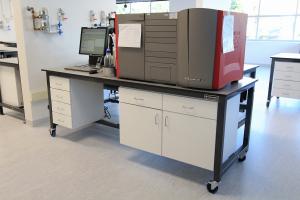What You Need to Know about Recent Discoveries in Cancer Treatment

Shown above is a blood laboratory with casework and other furniture elements built by Formaspace. It features a long seamless stainless steel countertop that runs the entire length of the laboratory, plus built-in stainless steel drawers and cabinets.
Find out about the new discoveries coming from cancer research laboratories, including updated recommendations to help identify cancer in its early stages.
But first, we should address the effect of the Covid pandemic on cancer research and the Life Sciences sector in general.
As you might expect, Covid has been a disruptive force over the past year, with many cancer research personnel having to adjust to working from home and many labs requiring updates to their facilities, including improving their ventilation systems, installing transparent barriers between lab stations, etc.
Cancer clinicians have also bemoaned the fact that during the height of the pandemic, many patients avoided coming into healthcare facilities at all – a troubling development for those who could have benefited from early cancer detection screening – when clinical treatment is easiest, and outcomes are most promising.
As a result, it’s widely believed we’ll see a significant uptick in cancer detection in the coming months as people return to healthcare facilities for regular screenings.
Many ongoing cancer drug trials were also disrupted by the pandemic as patients hesitated to sign up or elected to withdraw out of concerns over the Covid virus.
On the other hand, there have been some rare positive developments in the Healthcare and Life Sciences industry due to the Covid pandemic:
- One notable development is that the US did not experience any widespread influenza outbreak during the past “flu season,” presumably due to increased personal hygiene, including frequent handwashing as well as widespread mask wearing during the pandemic.
- Thanks to the rapid development and early success of Covid vaccines, there is renewed interest in life science research (including disease research and prevention) by the public, government officials, tech companies, investors, and the media. (We’ll investigate the current rapid growth of the Life Sciences sector in an upcoming series of articles.)
- The FDA and other drug regulators around the world have given provisional (emergency use) approval for RNA-based vaccines from BioNTech and Moderna, validating an approach championed by the once overlooked researcher Kati Kariko. This approval of RNA-based vaccines could greatly speed up the acceptance of other RNA-based therapies that pharma companies have in development, including so-called “cancer vaccines,” which we investigate below.
Could The Success Of Covid Vaccines Point The Way To New Funding Models For Disease Research?
There’s a fourth point as well.
The widely viewed success of “Operation Warp Speed” – the government initiative to provide massive funding to private companies seeking to develop a workable Covid vaccine as fast as possible (while shielding them from potential product liability) – has demonstrated that increased government funding support (and effective management) can deliver results.
This has increased calls to reassess (and hopefully increase) the role of public funding in drug research, with some scientists pointing to the groundbreaking research of Andrew W. Lo and Roger M. Stein, who, along with financial expert John Hull, wrote the 2019 paper “Funding Long Shots” that calls for a completely new funding framework (including Wall Street backing) to provide investor-backed financial support for disease research, including the search for new cures for cancer.
In a world of what many consider highly speculative investments (including SPACs, NFTs, DogeCoins, and the like), one has to believe that increased investment in health research would be a better bet in creating long-term positive change for our society than the alternatives.
The Biden administration has also taken notice of the calls for increased government support and has beefed up funding requests for Life Sciences (including cancer research) in the Recovery Act that passed earlier this year, as well as the proposed Federal Budget and Infrastructure bill.
Hopefully, this new funding will find its way to the likes of the NCI Experimental Therapeutics (NExT) program, which is the National Cancer Institute’s own “mini Operation Warpspeed” that helps coordinate funding for the most promising or novel cancer therapies – from the earliest stages of research all the way through to human clinical trials.
Which Are The Most Common Cancers Today?
Let’s turn our attention now to the latest research in cancer diagnostics, starting with the newest cancer incidence rankings.
At 11.7% of all cancers, breast cancer is now the number one most commonly diagnosed cancer world-wide, having supplanted the incidence of lung cancer (11.4%) – a drop that’s possibly linked to long-running anti-smoking campaigns. The next most common cancer diagnoses on a worldwide basis are colorectal (10%), prostate (7.3%), and stomach cancer (5.6%). In the US, the 2020 rankings are similar, except prostate cancer diagnoses outnumber those of colorectal cancer.
What about long-term trends?
Read more...
Julia Solodovnikova
Formaspace
+1 800-251-1505
email us here
Legal Disclaimer:
EIN Presswire provides this news content "as is" without warranty of any kind. We do not accept any responsibility or liability for the accuracy, content, images, videos, licenses, completeness, legality, or reliability of the information contained in this article. If you have any complaints or copyright issues related to this article, kindly contact the author above.



